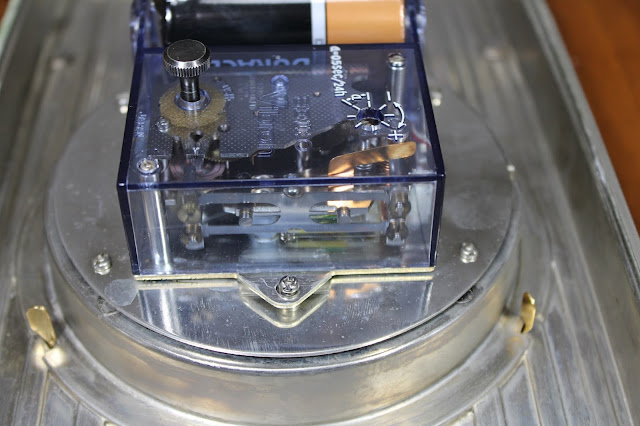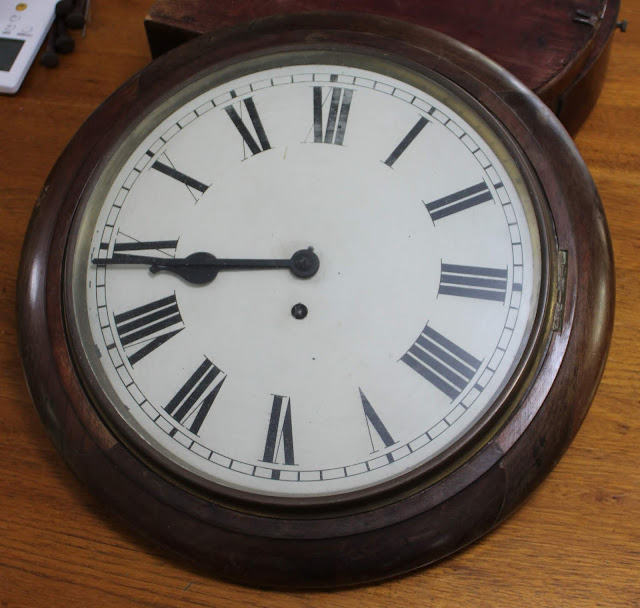Jaeger Le Coultre Atmos Swiss Clock 528.8 Calibre
Significance
Finally, a Jaeger Le Coultre Atmos Swiss Clock I could afford. As I collect mainly by technology, an Atmos clock is essential to a collection as they are unique, requiring no winding or batteries. Plus they are a very pretty brass and glass skeleton clock! Almost perpetual-motion, they are powered by daily oscillations of atmospheric temperature. The motor consists of bellows containing ethyl chloride which changes pressure with the temperature which winds the mainspring. The 17 jewel movement is high precision and very low energy; far less than a mechanical watch, much less a conventional mechanical clock.Description
The first commercial Atmos clock was developed by Jean Leon Reutter in 1928 although earlier attempts go back to 1740. The first Jaeger Le Coultre Atmos used a mercury and ammonia mechanism until 1938 before the current ethyl chloride mechanism was developed. About 500,000 have been made and are in current production. New, they start at about US$7000 for a classic similar to mine.Atmos clocks have long been an engineering curiosity and subject to a number of books and papers. See below for PDF sources of some. There are many web sites with information.
My clock as received, a bit sad but runs and is complete except for the back glass (perspex). The top brass cover was a bit bent but easily repaired. 528.8 calibre, c1970. Via eBay in Brisbane Qld. The top is perspex, not glass. The pendulum can be locked with the lever at the front. The front glass lifts out to set the time.
The parts of the mechanism. followed by a flow-chart of how they work. Basically, the movement of the bellows winds the mainspring and a torsional pendulum is an accurate oscillation. The movement is very low energy and friction.

A torsional pendulum is a mass-spring oscillation where the restoring force depends on the characteristics of the twist in the suspension wire/spring. As such it is sensitive to the quality of the spring and temperature. The spring is made of Elinvar, similar to Invar, a nickel-iron-chromium alloy insensitive to temperature, invented by Charles Édouard Guillaume, a Swiss physicist c1920, awarded a Nobel Prize.
Book and papers (pdf)
Living On Air History of The Atmos Clock by Jean Lebethttp://xray.rutgers.edu/~matilsky/documents/Atmos/Atmos-Living_On_Air_final.pdf
https://tigerprints.clemson.edu/mecheng_pubs/8/ Operating Principles, Common Questions, and Performance Data for an Atmospheric Driven Atmos Clock (pdf)
http://folk.ntnu.no/skoge/prost/proceedings/ecc-2013/data/papers/0032.pdf Engineering analysis of atmos clock.
Resources
https://en.wikipedia.org/wiki/Atmos_clockhttps://en.wikipedia.org/wiki/Jaeger-LeCoultre
http://www.atmosadam.com/howitworks.html
http://www.atmosadam.com/
http://www.atmos-man.com/atmoshistory.html
http://www.atmosman.com/atmocare.html
http://www.atmosman.com/earthpdf.html ----index for site
http://www.atmosclock.us/atmopart.html parts
http://www.clubderelojeria.com/comunicaciones/J/jeager/atmos.pdf
https://insuremekevin.com/download/7003/clocks/24382/how-to-repair-atmos-perpetual-motion-clocks.pdf
Huge list of documents on many watches and some clocks
http://www.clubderelojeria.com/comunicaciones/J/jeager/jeager.php
https://www.youtube.com/watch?v=-i8AAnsLN84 How to Start Jaeger LeCoultre Atmos Clock
https://www.youtube.com/watch?v=P5dIqH-Q-ow Jaeger LeCoultre Atmos Clock Repair






Comments
Post a Comment